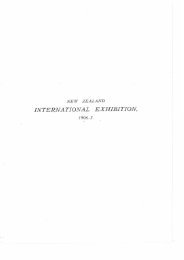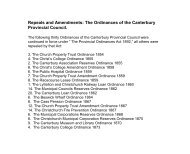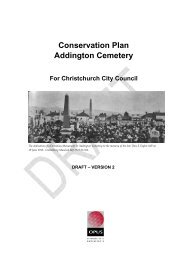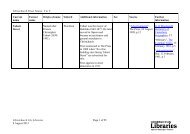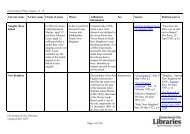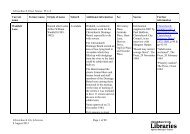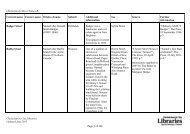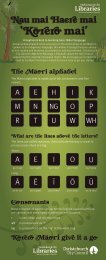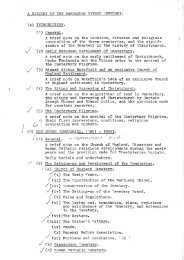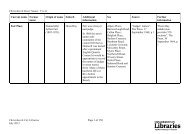Puawaitanga o te Ringa - Christchurch City Libraries
Puawaitanga o te Ringa - Christchurch City Libraries
Puawaitanga o te Ringa - Christchurch City Libraries
You also want an ePaper? Increase the reach of your titles
YUMPU automatically turns print PDFs into web optimized ePapers that Google loves.
Stories Stories of of the the the Tukutuku Tukutuku Pat<strong>te</strong>rns<br />
Pat<strong>te</strong>rns<br />
Tukutuku pat<strong>te</strong>rns vary considerably from iwi to iwi throughout the land. Certain designs are associa<strong>te</strong>d<br />
with particular iwi, some may have different names in different regions, or the names may be spelled<br />
in various ways. Many forms are rela<strong>te</strong>d to mythologies, the stories about them vary from iwi to iwi.<br />
Some of the traditions are recorded here; this information has been drawn heavily from the works of<br />
Te Rangi Hiroa, and of John M. Mepham at Tokomaru Bay. Hiroa has sugges<strong>te</strong>d that the simpler forms<br />
are probably the older designs, la<strong>te</strong>r pat<strong>te</strong>rns developed pictorial forms, such as ancestral figures or<br />
other shapes. The Püawaitana o <strong>te</strong> <strong>Ringa</strong> designs make no claim to be authorative but have been<br />
inspired by traditional pat<strong>te</strong>rns; only the Aoraki panel has a simplified pictorial form.<br />
Aoraki<br />
Aoraki<br />
The Aoraki panel was designed to acknowledge Ngäi Tahu as Tangata Whenua. Chevrons of the niho<br />
taniwha pat<strong>te</strong>rn crea<strong>te</strong> the form of the mountain Aoraki, which might well be seen as a taniwha by the<br />
disrespectful or the unprepared. Stitches of whi<strong>te</strong> kiekie indica<strong>te</strong> the mountain’s snowy covering<br />
while the repea<strong>te</strong>d chevrons signify the layers of its geological structure. The mountain reaches up to<br />
the purapura whetü stars in the sky. Two small whi<strong>te</strong> niho taniwha triangles on either side of the<br />
mountain allude to the southern alps; and in the foreground, three triangles of pïngao represent<br />
tussock covered foothills.<br />
Kaokao<br />
Kaokao<br />
The kaokao (bend or side of the ribs) designs of Te Arawa and East Coast iwi are formed by zig zag<br />
lines that crea<strong>te</strong> chevrons that can be horizontal or vertical, open with paces or closed repetitive<br />
lines. It is sometimes seen to represent the sides and arms of warriors as if caught in haka action.<br />
Niho Niho Taniwha<br />
Taniwha<br />
Niho Taniwha has been identified as a pat<strong>te</strong>rn of Te Arawa and Waikato iwi. The <strong>te</strong>eth-like triangular<br />
shapes of niho taniwha are ‘dragon’s’ <strong>te</strong>eth; they are usually arranged in vertical rows with the apex at<br />
the top.<br />
Roimata<br />
Roimata<br />
Four panels show variations of the roimata (<strong>te</strong>ars) pat<strong>te</strong>rn, based on vertically stitched rows, frequently<br />
in pairs, that are separa<strong>te</strong>d in the same number of nonstitched rows. An Arawa design known as<br />
roimata toroa (albatross <strong>te</strong>ars) has al<strong>te</strong>rna<strong>te</strong> parallel rows in vertical blocks, while in a similar Whanganui<br />
design was shown as tuturu (leaking wa<strong>te</strong>r) or turuturu (falling raindrops). In the Ngäti Porou story of<br />
how the kumara came to New Zealand, the ancestor Pourangahua left his wife on the East Coast<br />
when he returned to Hawaiki to obtain the tubers. There, his tohunga Ruakapanga not only gave him<br />
baskets containing the kumara tubers but also two sacred birds, to help him return. He instruc<strong>te</strong>d<br />
Pourangahua that he must give prayers of thanksgiving on his safe arrival back in New Zealand, as well<br />
as prayers for the safe return of the sacred birds back to Hawaiki, and for a bountiful kumara harvest.<br />
However, in his joy at being reuni<strong>te</strong>d with his beautiful wife, Pouranahua forgot his instructions. La<strong>te</strong>r,<br />
he found the albatross birds weeping, their <strong>te</strong>ars alling onto their breasts. One had been crying so<br />
long that its <strong>te</strong>ars were just dripping, short <strong>te</strong>ars. The other cried long <strong>te</strong>ars - roimata toroa. Accordingly,<br />
for Ngäti Porou, the roimata turuturu design shows long and short <strong>te</strong>ars.<br />
28



